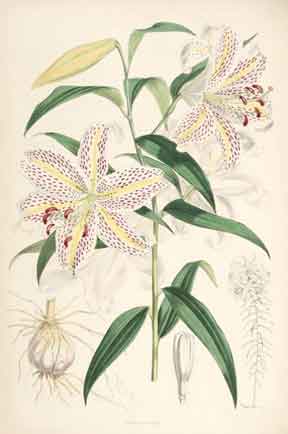Question: We would like to grow some lilies in our rock garden, which varieties are best suited to rock garden culture? Beverly, Goldsboro, North Carolina
Answer: Beverly, there are a few lily varieties to use in rock gardens. Here, the smaller, shorter-stemmed varieties, such a Lilium amabile, L. cernuum, L. concolor, L. rubellum, L. maculatum (elegans) and L. pumilum (tenttifolium), should be used, particularly if the area is small. Plant them where their roots will be shaded, on the north side of a large rock, for instance, because the rock garden may be too well drained and dry for their liking.
Even woodlands with light shade or a place where sun penetrates only a few hours a day are not impossible places for lilies. Lilium auratum. L. henryi, L. hansoni, L. canadense, L. superbum, L. rubellum, L. japonicum. L. humboldti and other hybrids have been used where shade was not too dense and soil and drainage good.

Ferns make excellent gioundcovers in these spots, and ajuga. hosta and other woodland denizens with a shady past and future will flourish as companions. Where lilies are naturalized, native shade plants can be used as accompaniments. and both blue and Hills of Snow hydrangeas make good shrub neighbors. Actually, the possibilities for the use of lilies are limited only by the imagination.
Lilies are not as capricious inmates of the garden as once was believed. And if we provide them with favorable conditions for growth and health, they’ll thank us with unstinted bloom.
Getting Cultural On The Landscape Lilies
Well-drained soil is the first requisite, for bulbs should not have to deal with excess moisture, especially during dormancy or rot and fungus diseases may result. Even lilies which are natives to boggy regions perch themselves on hummocks so that only the roots rest in soggy soil. Therefore, before planting, cultivate the soil deeply and add drainage where necessary. An open, porous, rich-in-humus soil which allows excess water to drain off but is still spongy enough to hold moisture during the growing season is ideal.
It’s generally agreed that a fertilizer with a high potash content makes lilies more disease-resistant, while one high in nitrogen results in soft, weak sterns. One authority recommends 3 parts dried manure to 1 part bonemeal, with 3 or more parts wood ashes (potash) unless the soil is unduly alkaline, for most lilies seem to prefer neutral to slightly acid soils.
If commercial plant foods are used, those with 2-8-10 or 0.10-10 analyses are preferred, although a 5-10-5 one is all right if extra potash is added in some other form.
Avoid air stagnation around lilies. Air movement will assist in maintaining their health, but sweeping winds, of course, will result in snapped stems and damaged flowers despite staking and tying.
Mulching during the growing season conserves moisture and eliminates weeding, hut use an open, porous, mulching material so that air and rain may penetrate freely. A winter mulch is appreciated – especially the first year of planting. It prevents heaving and breakage of new roots as well as too-early spring growth which may be nipped by late spring frosts.
These, then, are the quick facts about lilies and their use. Don’t shortchange them, but use them to their fullest, surround them with good companions and invite yourself to the garden party.
by J Brimer
